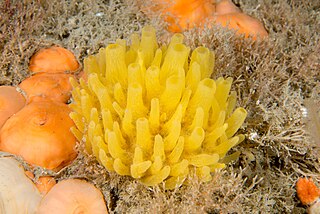
Hexasterophora are a subclass of glass sponges in the class Hexactinellida. Most living hexasterophorans can be divided into three orders: Lyssacinosida, Lychniscosida, and Sceptrulophora. Like other glass sponges, hexasterophorans have skeletons composed of overlapping six-rayed spicules. In addition, they can be characterized by the presence of hexasters, a type of microsclere with six rays unfurling into multi-branched structures.

Geodia is a genus of sea sponge belonging to the family Geodiidae. It is the type genus of its taxonomic family.

Polymastia is a genus of sea sponges containing about 30 species. These are small to large encrusting or dome-shaped sponges with a smooth surface having many teat-shaped projections (papillae). In areas of strong wave action, this genus does not grow the teat structures, but instead grows in a corrugated form.

Plakinidae is a family of marine sponges. It is composed of seven genera:

Lyssacinosida is an order of glass sponges (Hexactinellida) belonging to the subclass Hexasterophora. These sponges can be recognized by their parenchymal spicules usually being unconnected, unlike in other sponges in the subclass where the spicules form a more or less tightly connected skeleton. Lyssacine sponges have existed since the Upper Ordovician, and three families are still alive today. The Venus' flower basket is one of the most well-known and culturally significant of the glass sponges.

Stelletta is a genus of sea sponges belonging to the family Ancorinidae.

Auletta is a genus of sponges in the family Bubaridae.

Mycalidae is a family of marine demosponges.

Crella is a genus of marine demosponges in the family Crellidae.

Rossellidae is a family of glass sponges belonging to the order Lyssacinosa. The family has a cosmopolitan distribution and is found at a large range of depths.

Caulophacus is a genus of glass sponges belonging to the subfamily Lanuginellinae.

Staurocalyptus is a genus of sponge. It was circumscribed in 1897 by Isao Ijima.

Mycale is a genus of demosponge with 240 recognised species in 11 subgenera. It has been a large genus with multiple subdivisions since it was first described in 1867.
Amphidiscella is a genus of sea sponge in the family Euplectellidae.
Sceptrulophora is an order of hexactinellid sponges. They are characterized by sceptrules, a type of microsclere with a single straight rod terminating at a bundle of spines or knobs. An anchor- or nail-shaped sceptrule is called a clavule. A fork-shaped sceptrule, ending at a few large tines, is called a scopule. A broom-shaped sceptrule, ending at many small bristles, is called a sarule.

Farrea is a genus of glass sponges in the family Farreidae.
Chonelasma is a genus of sea sponge in the family Euretidae.

Bolosoma is a genus of pedunculated siliceous sponges belonging to the family Euplectellidae. This genus lives in deep-sea environments and provides a habitat for a plethora of other benthic species, giving Bolosoma an incredibly important ecological role in the ecosystems it is a part of.
Hamacantha is a genus of sponges in the family Hamacanthidae. This species in this genus differ from those in the other genera in this family through the presence of diancistras, distinctive microscleres. These are thought to aid in framing the skeleton by joining monactine megascleres. This genus contains 30 species in three subgenera.















